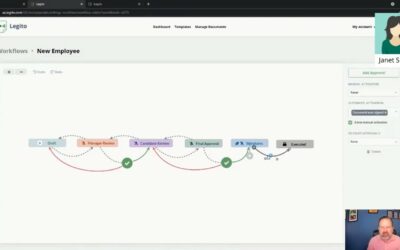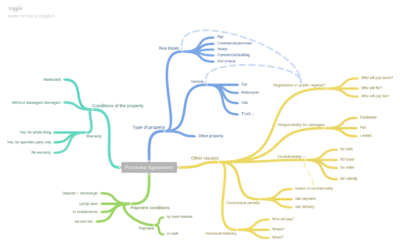Democratizing Enterprise Contracts
Democratizing Enterprise Contracts
Automation as a tool for reducing bottlenecks with In-House Legal and other teams
Most companies sell a product or service to generate revenue. Of course, commercial teams actually sell the products, but other departments are just as essential to day-to-day operations, such as Human Resources, Finance, Compliance, and Legal. These teams do not operate in a bubble, but constantly rely on one another for knowledge sharing, and quick decision making.
In-house legal teams tend to work with each of these departments and are involved with just about every aspect of decision-making processes. Often perceived as an unfortunate but necessary “spend,” many legal departments’ true tasks help guarantee uninterrupted and increased revenue.
Documentation, operational transparency, and ease of access to information are some of the unsung responsibilities legal departments must resolve to keep the business functional.
Interconnectedness / interdependencies between teams, especially as they intersect with the scope of responsibilities of the in-house Legal team, can create serious consequences for any company.
But there is hope, and Document Automation and Contract Lifecycle Management is it.
The Challenges
What could go wrong? A lot actually. Some of the most prominent challenges for each team are below:
Legal Team
Legal teams form the backbone of the company itself. A team of highly educated attorneys spends a lot of time making simple and often minor changes to contracts, like changing a clause on governing law, or assignment, as well as maintaining several different versions of templates for different departments.
And of course, the Legal team is the go-to department for time consuming but low priority questions like “can we make this product?”
This leads to a bottleneck because the legal team ends up spending the majority of their time doing document maintenance for which they are overqualified. Meanwhile, the places where they can really provide value (and where they want to provide value); negotiation of terms, analysis and mitigation of potential risks to the company itself are either pushed to the back, or limited in the time they can be given.
Hiring more legal professionals is one option but that creates additional costs and has risks in itself, and as lawyers know, the more hands there are, the more work appears.
What to do? How can legal teams get back to the work they need to do, while retaining control over contracts and other language and policies?
The Commercial Team
Commercial teams sell the product – be it in an online store, or a multi-month B2B sales cycle, and get the paperwork into the hands of customers.
Without the proper technology, opaque contracting process leads to back and forth between parties, and this “ping-pong” effect extends sales cycles – sometimes to where it takes months to negotiate the full contract after the essential terms (price, quantity, delivery) are amicably agreed by the commercial teams; because legal review drags on.
It can also create high risk contracts (e.g., lawsuits or non-compliance to regulations and law), and most importantly, a lack of trust between employees, the company, and its customers.
The bottom line is that where bottlenecks exist, the bottom line is affected. Not only to contracts take longer to negotiate past the basic, mutually agreeable broad strokes, but in an effort to expedite the process unapproved or outdated clauses can appear that create liability where none should exist, and in the worst cases – revenue is lost because it just takes so long to get the deal done.
But how to support the bottom line without exposure to risk or hiring packs of lawyers just to negotiate deals quickly?
Human Resources
Human Resources teams, or “People Services,” not only make sure of the welfare of all the employees at an organization, but also work to make sure the organization stays safe from risk. Many of HR’s responsibilities require legal oversight and review along with coordination with the Risk and Compliance departments to ensure compliance with law and business standards.
The ability to hire people quickly in a competitive market makes it imperative that HR teams move quickly to secure candidates before they are snatched up by a competitor. The faster employment contracts can be generated, delivered, and executed, the better.
If only there was a way to streamline this process so that HR can hire quickly and efficiently, while maintaining compliance with regulatory matters.
These aren’t the only departments who face challenges as part of an integrated/interdependent business environment, just the best known. Challenges exist anywhere where teams need, but don’t have the most up-to-date, approved language/policies, or can’t move deals forward for lack of legal review.
Automation to the Rescue
Almost every commercial enterprise encounters these challenges in their day-to-day activities, but they are difficult to “manage away”or “hire away.” Finding a solution specific to an organization requires finding tools that are both robust and flexible.
Document Automation and Contract Lifecycle Management tools are the answer.
When properly leveraged, the right Document Automation and Contract Lifecycle Management software democratizes the contracting and document management process, because the Legal team is not the “holder” of all of the contracts. Though they provide the components, the contracts can live on their own among the teams involved removing organizational blockers.
Granting more autonomy to different departments (i.e., granting more document creation ability) saves time for everyone, while assuring legal teams of the accuracy and compliance of all the company’s documents.
What can these tools do?
Automated Document Assembly
Commercial team members can now create their own contracts without needing to be experts in contract law.
Representatives may enter deal information from their opportunities (or have the fees and product details automatically extracted) to automatically draft contracts that contain the correct terms, conditions, and ancillary documents – all created by legal, but locked to protect against unknown-added risk.
Approved language dynamically completes agreements, so the highly qualified legal team personnel spend less time drafting and reviewing contract language, and more time on high value projects.
Conversely, Legal retains control over the clause language itself, so they can be secure in the knowledge that even though contracting is democratized, and commercial teams are able to do their own contract assembly, they are not somehow letting the genie out of the bottle and opening the company up to risk or compliance issues by turning untrained commercial team members into de facto lawyers.
In some cases, this approach can reduce Legal team workload in contract drafting/review by up to 95 %, and reduce time to execution from several months down to a matter of days.
But the benefits occur also to Human Resources and Finance departments, who are able to automatically populate information from external databases or spreadsheets to quickly complete forms and reports.
Workflows and Approvals
Although fewer deals require legal review, for situations that require language that is not dynamically drafted into agreements by the software, or available in a clause library, clear and transparent Workflow and Approval processes are defined.
There is no longer any guess work about who is responsible for the approval, and there is always visibility on what stage of the review process the contract is in. Legal no longer bears the full responsibility – all the key stakeholders are accountable for their role in completing contract negotiation.
Documents that require review and approval from different departments can be routed quickly to the correct departments using predefined rules.
Communication Tools
Sharing documents and information quickly is important, but being able to share information and notes, new information, and comments is just as crucial. In Document comments, Real-Time Conversations / Chat, Track Changes, and Redlining features help all the stakeholders stay connected.
Deadline Reminders
Data pulled from contracts automatically creates deadline notifications for renewals, and termination notice dates. This gives teams plenty of time to prepare renewal negotiations, for the organization to get out of bad contracts, or to repaper contracts that fall foul of new regulatory obligations.
Conclusion
Interconnectedness and interdependencies between legal and other teams within any company creates inherent challenges for each team involved.
Legal teams are overburdened by the need to review/approve documents – including agreed but unexecuted sales agreements, also to maintain compliance, and defend against risk. Commercial teams are delayed by overburdened legal teams, and HR teams need legal review for hiring, layoffs, and changes in compensation. Being the hub of interdepartmental resources inevitably forces the legal team to slow down process flows, in order to protect the organization.
But there is hope.
Document Automation Tools help all of a company’s key departments work seamlessly with Legal, and with one another through the Legal team to increase overall productivity, while maintaining the necessary level of risk protection, compliance, rights maintenance, and others. Granting more autonomy to different departments (i.e., granting more document creation ability) saves time for everyone, while assuring legal teams of the accuracy and compliance of all the company’s documents.
In other words: They make it possible to democratize contracting. Automated Document Assembly / Contract Lifecycle Management is not just a solution that is solely for the benefit of Legal, but is a necessary business tool for the entire organization’s success.
More Industry Insights


















